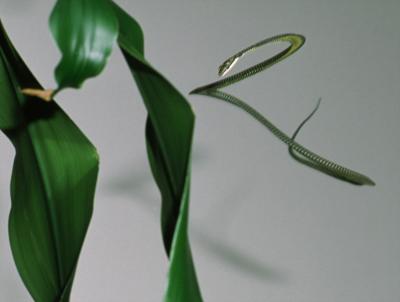What makes flying snakes such gifted gliders?

The flattened shape of a flying snake in flight allows it to get lift from little whirls of wind (vortices) around it. Credit: Copyright: Jake Socha
Animal flight behavior is an exciting frontier for engineers to both apply knowledge of aerodynamics and to learn from nature's solutions to operating in the air. Flying snakes are particularly intriguing to researchers because they lack wings or any other features that remotely resemble flight apparatus.
Before you envision flying snakes raining down from the sky, the ones involved in this study are small — about 1 meter in length and the width of your thumb — and live in the lowland tropical forests of Asia and Southeast Asia.
Virginia Tech Assistant Professor Jake Socha, renowned for his work with flying snakes, recently teamed with Boston University and George Washington University researchers to explore snakes' lift and wakes using computer simulations. They describe their work in the journal Physics of Fluids.
Previously, experiments in a wind tunnel had returned an unexpected finding: the snake's shape is not only good at generating a force of lift, but it also gets an extra boost of lift when facing the air flow at a certain angle.
“After experiments uncovered this, we decided to use computer simulations to try to explain it,” says Lorena Barba, associate professor of mechanical and aerospace engineering at the George Washington University.
So much of the aerodynamics of animal flight — especially that of flying snakes — remain a mystery. Scale is important, but also the manner in which flight is achieved.
“Rather than fixed wings, animal fliers have flapping wings,” explains Barba. “In the case of gliders, their small scale means they're always in a flurry of whirling winds. By understanding how they can be graceful and efficient under these conditions, we can in turn use that knowledge to create small flying machines that are equally graceful.”
Whirls of wind can be particularly useful: these little vortices “can give flying snakes an extra lift,” notes Barba. “The shape of the snakes in flight — which is a flattened version of its shape at rest — gets help from little vortices around it.”
Next, the researchers would like to include more elements of the snake's real gliding conditions into their computer simulations, such as its full body forming an S-shape, rather than working with just a section.
“This will be more difficult to do in a computer model, but it will probably reveal more about the complicated flow patterns snakes take advantage of to be such gifted gliders,” Barba says.
The article, “Lift and wakes of flying snakes” (DOI: 10.1063/1. 4866444) is authored by Anush Krishnan, John J. Socha, Pavlos P. Vlachos, L. A. Barba. It will be published in the journal Physics of Fluids on on March 4, 2014. After that date, it may be accessed at: http://scitation.aip.org/content/aip/journal/pof2/26/3/10.1063/1.4866444?
ABOUT THE JOURNAL
Physics of Fluids is devoted to the publication of original theoretical, computational, and experimental contributions to the dynamics of gases, liquids, and complex or multiphase fluids. See: http://pof.aip.org
Media Contact
All latest news from the category: Life Sciences and Chemistry
Articles and reports from the Life Sciences and chemistry area deal with applied and basic research into modern biology, chemistry and human medicine.
Valuable information can be found on a range of life sciences fields including bacteriology, biochemistry, bionics, bioinformatics, biophysics, biotechnology, genetics, geobotany, human biology, marine biology, microbiology, molecular biology, cellular biology, zoology, bioinorganic chemistry, microchemistry and environmental chemistry.
Newest articles

Properties of new materials for microchips
… can now be measured well. Reseachers of Delft University of Technology demonstrated measuring performance properties of ultrathin silicon membranes. Making ever smaller and more powerful chips requires new ultrathin…

Floating solar’s potential
… to support sustainable development by addressing climate, water, and energy goals holistically. A new study published this week in Nature Energy raises the potential for floating solar photovoltaics (FPV)…

Skyrmions move at record speeds
… a step towards the computing of the future. An international research team led by scientists from the CNRS1 has discovered that the magnetic nanobubbles2 known as skyrmions can be…





















